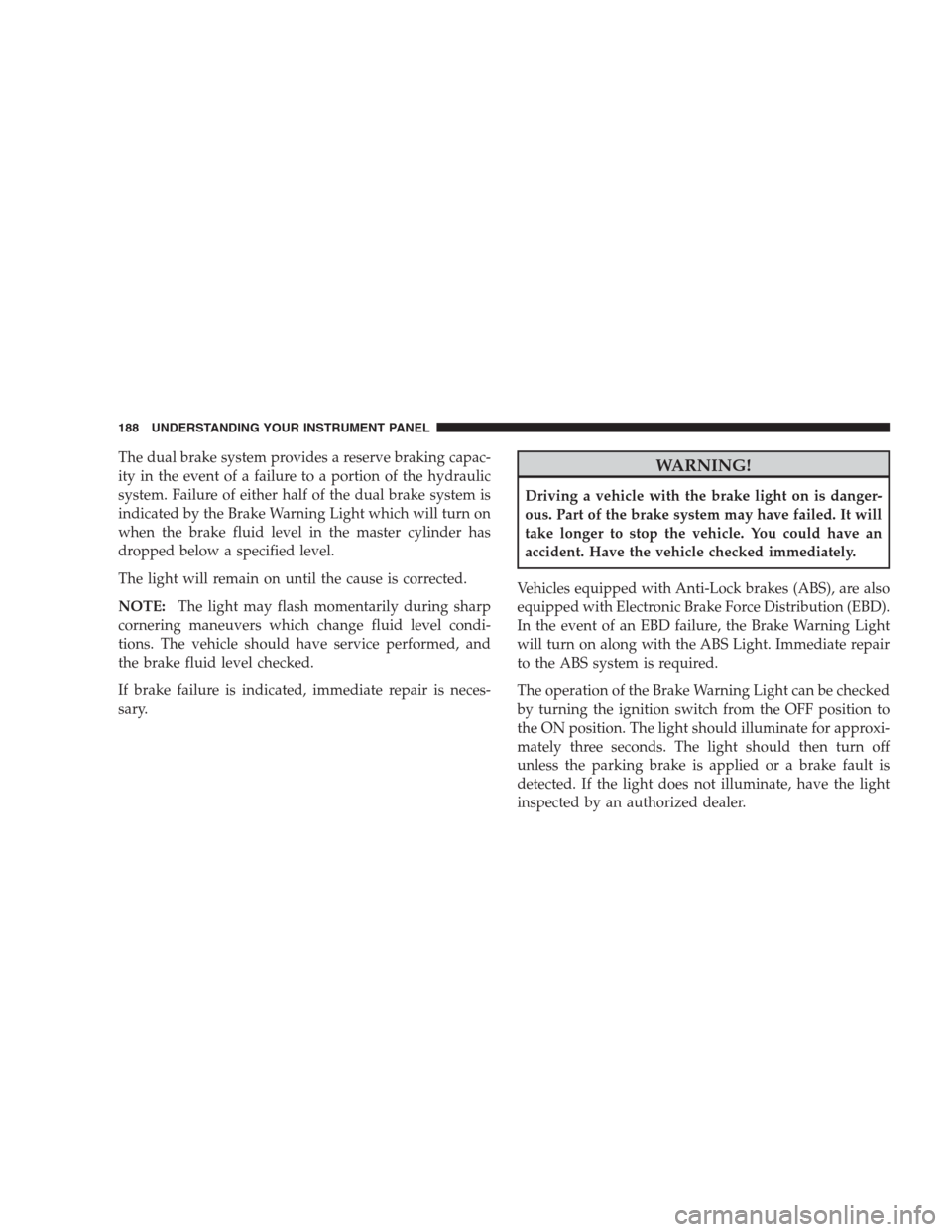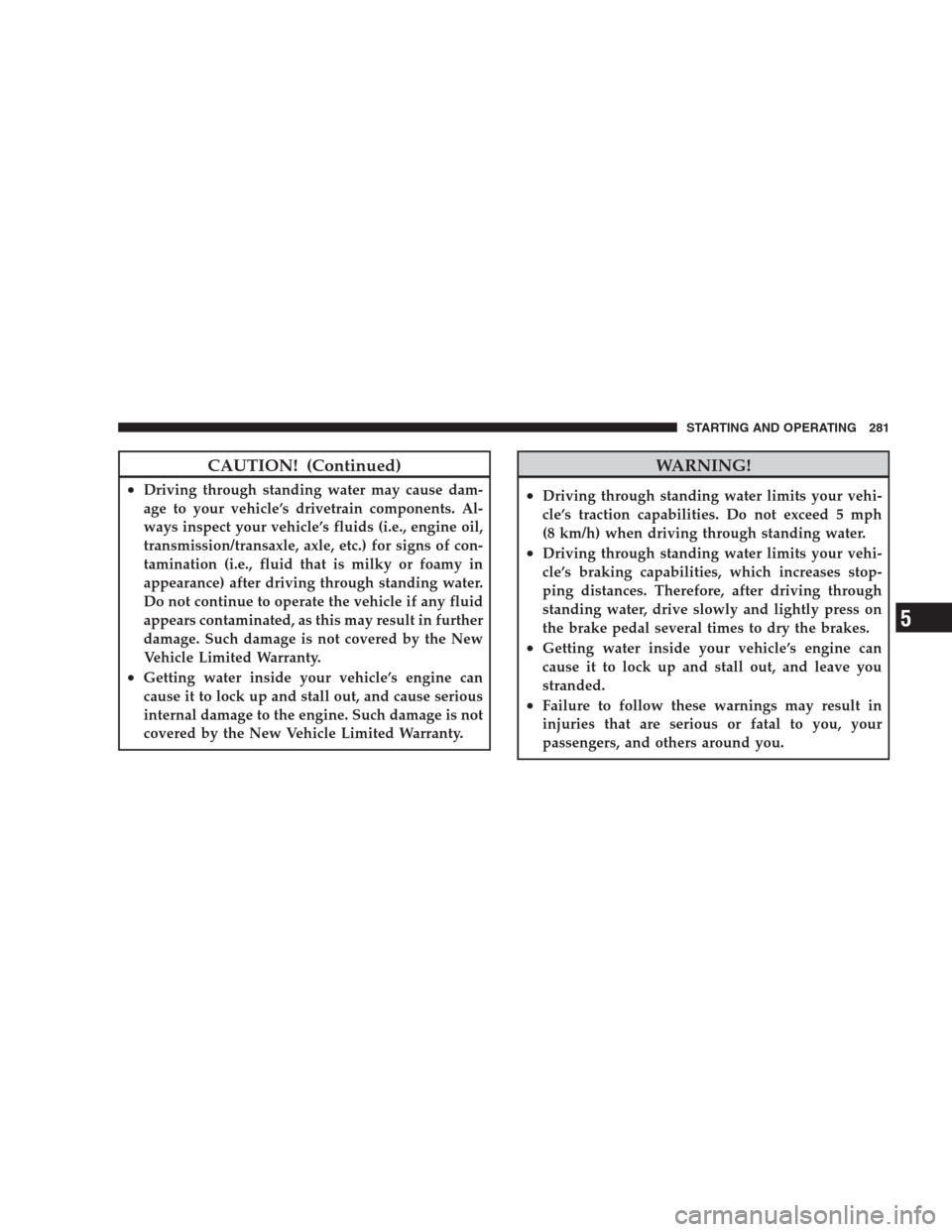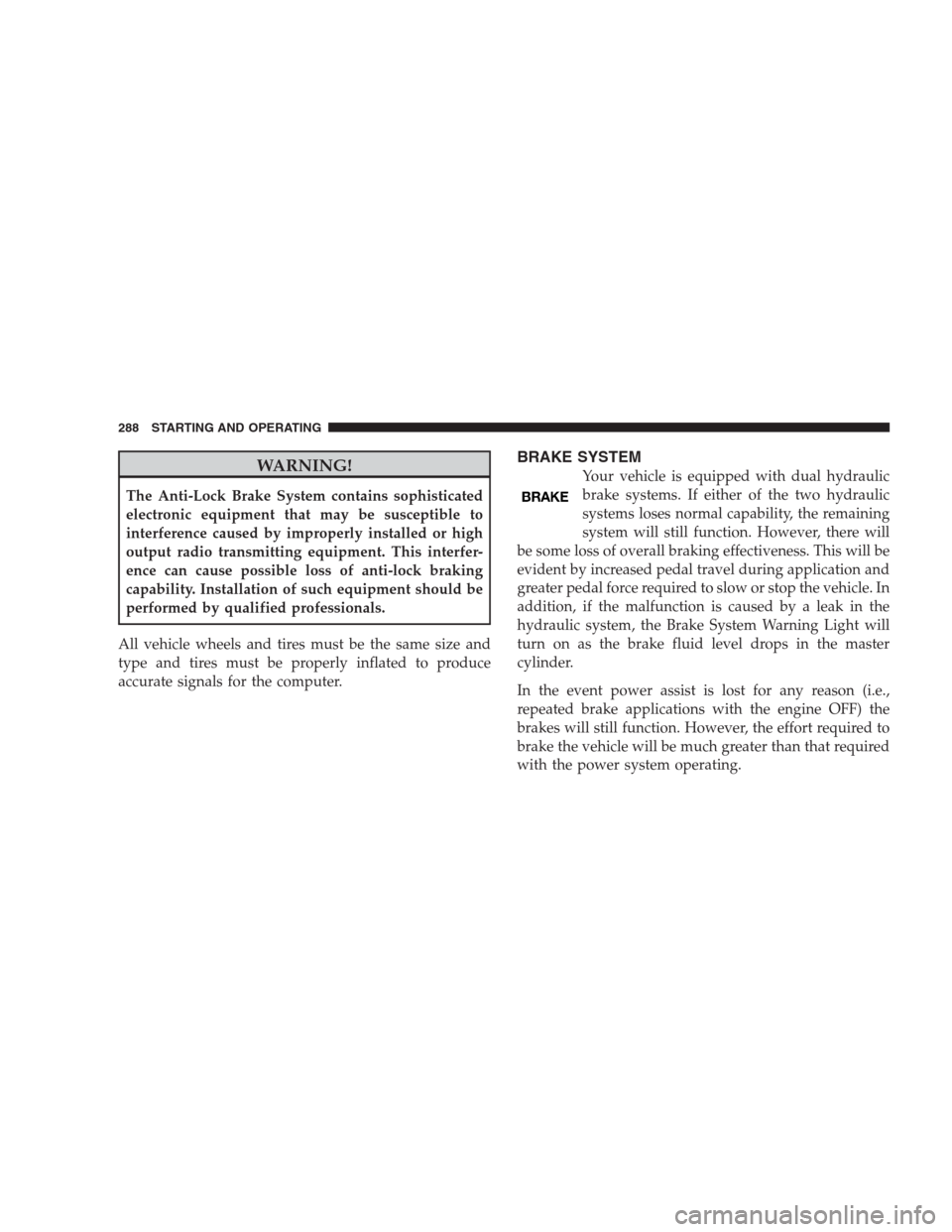Page 78 of 475
Lights
Have someone observe the operation of exterior lights
while you work the controls. Check turn signal and high
beam indicator lights on the instrument panel.
Door Latches
Check for positive closing, latching, and locking.
Fluid Leaks
Check area under vehicle after overnight parking for fuel,
engine coolant, oil, or other fluid leaks. Also, if gasoline
fumes are detected or if fuel, power steering fluid, or
brake fluid leaks are suspected, the cause should be
located and corrected immediately.
76 THINGS TO KNOW BEFORE STARTING YOUR VEHICLE
Page 189 of 475

17. Electronic Throttle Control (ETC) Indicator Light
This light informs you of a problem with the
Electronic Throttle Control (ETC) system. If a
problem is detected, the light will come on
while the engine is running. If the light remains
lit with the engine running your vehicle will usually be
drivable and not need towing, however see your dealer
for service as soon as possible.
If the light is flashing when the engine is running you
may experience power loss, an elevated/rough idle, and
increased brake pedal effort, and your vehicle may
require towing. Immediate service is required.
The light will come on when the ignition switch is first
turned on and remain on approximately 15 seconds as a
bulb check. This is normal. If the light does not come on
during starting, have the system checked by an autho-
rized dealer.18. Electronic Stability Program (ESP) Indicator Light
/ Traction Control System (TCS) Indicator Light — If
Equipped
If this indicator light flashes during accelera-
tion, apply as little throttle as possible. While
driving, ease up on the accelerator. Adapt your
speed and driving to the prevailing road con-
ditions, and do not switch off the Electronic Stability
Program (ESP), or Traction Control System (TCS).
19. Brake Warning Light
This light monitors various brake functions,
including brake fluid level and parking brake
application. If the brake light turns on, it may
indicate that the parking brake is applied, that
the brake fluid level is low, or that there is a problem with
the anti-lock brake system (if equipped).
UNDERSTANDING YOUR INSTRUMENT PANEL 187
4
Page 190 of 475

The dual brake system provides a reserve braking capac-
ity in the event of a failure to a portion of the hydraulic
system. Failure of either half of the dual brake system is
indicated by the Brake Warning Light which will turn on
when the brake fluid level in the master cylinder has
dropped below a specified level.
The light will remain on until the cause is corrected.
NOTE:The light may flash momentarily during sharp
cornering maneuvers which change fluid level condi-
tions. The vehicle should have service performed, and
the brake fluid level checked.
If brake failure is indicated, immediate repair is neces-
sary.WARNING!
Driving a vehicle with the brake light on is danger-
ous. Part of the brake system may have failed. It will
take longer to stop the vehicle. You could have an
accident. Have the vehicle checked immediately.
Vehicles equipped with Anti-Lock brakes (ABS), are also
equipped with Electronic Brake Force Distribution (EBD).
In the event of an EBD failure, the Brake Warning Light
will turn on along with the ABS Light. Immediate repair
to the ABS system is required.
The operation of the Brake Warning Light can be checked
by turning the ignition switch from the OFF position to
the ON position. The light should illuminate for approxi-
mately three seconds. The light should then turn off
unless the parking brake is applied or a brake fault is
detected. If the light does not illuminate, have the light
inspected by an authorized dealer.
188 UNDERSTANDING YOUR INSTRUMENT PANEL
Page 266 of 475

▫Traction........................... 279
�Driving Through Water................. 280
▫Flowing/Rising Water................. 280
▫Shallow Standing Water............... 280
�Power Steering....................... 282
▫Power Steering Fluid Check............. 282
�Parking Brake........................ 283
�Anti—Lock Brake System (ABS)........... 285
�Brake System........................ 288
▫Anti-Lock Brake System — If Equipped.... 289
�Electronic Brake Control System........... 292
▫Anti-Lock Brake System (ABS)........... 292
▫Traction Control System (TCS)........... 292▫Brake Assist System (BAS).............. 293
▫Electronic Stability Program (ESP)........ 294
�Tire Safety Information................. 297
▫Tire Markings....................... 297
▫Tire Identification Number (TIN)......... 301
▫Tire Loading And Tire Pressure.......... 302
�Tires — General Information............. 306
▫Tire Pressure....................... 306
▫Tire Inflation Pressures................ 307
▫Radial-Ply Tires..................... 309
▫Compact Spare Tire — If Equipped....... 310
▫Limited Use Spare — If Equipped........ 311
▫Tire Spinning....................... 312
264 STARTING AND OPERATING
Page 283 of 475

CAUTION! (Continued)
•Driving through standing water may cause dam-
age to your vehicle’s drivetrain components. Al-
ways inspect your vehicle’s fluids (i.e., engine oil,
transmission/transaxle, axle, etc.) for signs of con-
tamination (i.e., fluid that is milky or foamy in
appearance) after driving through standing water.
Do not continue to operate the vehicle if any fluid
appears contaminated, as this may result in further
damage. Such damage is not covered by the New
Vehicle Limited Warranty.
•Getting water inside your vehicle’s engine can
cause it to lock up and stall out, and cause serious
internal damage to the engine. Such damage is not
covered by the New Vehicle Limited Warranty.
WARNING!
•Driving through standing water limits your vehi-
cle’s traction capabilities. Do not exceed 5 mph
(8 km/h) when driving through standing water.
•Driving through standing water limits your vehi-
cle’s braking capabilities, which increases stop-
ping distances. Therefore, after driving through
standing water, drive slowly and lightly press on
the brake pedal several times to dry the brakes.
•Getting water inside your vehicle’s engine can
cause it to lock up and stall out, and leave you
stranded.
•Failure to follow these warnings may result in
injuries that are serious or fatal to you, your
passengers, and others around you.
STARTING AND OPERATING 281
5
Page 285 of 475

apparent, and/or the system is not functioning as antici-
pated. Coordinate inspection efforts through an autho-
rized dealer.
No chemical flushes should be used in any power
steering system; only the approved lubricant may be
used.
WARNING!
Fluid level should be checked on a level surface and
with the engine off to prevent injury from moving
parts and to ensure accurate fluid level reading. Do
not overfill. Use only manufacturer’s recommended
power steering fluid.
If necessary, add fluid to restore to the proper indicated
level. With a clean cloth, wipe any spilled fluid from all
surfaces. Refer to “Fluids, Lubricants, and Genuine
Parts” in Section 7 for the correct fluid type.
PARKING BRAKE
The parking brake should always be applied when the
driver is not in the vehicle.
WARNING!
Never use the PARK position as a substitute for the
parking brake. Always apply parking brake fully
when parked to guard against vehicle movement and
possible injury or damage.
When parking on a flat surface, place the shift lever in the
PARK position first, and then apply the parking brake.
When parking on a hill, it is important to apply the
parking brake before placing the shift lever in PARK,
otherwise the load on the transaxle locking mechanism
may make it difficult to move the shift lever out of PARK.
STARTING AND OPERATING 283
5
Page 290 of 475

WARNING!
The Anti-Lock Brake System contains sophisticated
electronic equipment that may be susceptible to
interference caused by improperly installed or high
output radio transmitting equipment. This interfer-
ence can cause possible loss of anti-lock braking
capability. Installation of such equipment should be
performed by qualified professionals.
All vehicle wheels and tires must be the same size and
type and tires must be properly inflated to produce
accurate signals for the computer.
BRAKE SYSTEM
Your vehicle is equipped with dual hydraulic
brake systems. If either of the two hydraulic
systems loses normal capability, the remaining
system will still function. However, there will
be some loss of overall braking effectiveness. This will be
evident by increased pedal travel during application and
greater pedal force required to slow or stop the vehicle. In
addition, if the malfunction is caused by a leak in the
hydraulic system, the Brake System Warning Light will
turn on as the brake fluid level drops in the master
cylinder.
In the event power assist is lost for any reason (i.e.,
repeated brake applications with the engine OFF) the
brakes will still function. However, the effort required to
brake the vehicle will be much greater than that required
with the power system operating.
288 STARTING AND OPERATING
Page 370 of 475

▫Windshield Washers.................. 385
▫Exhaust System..................... 386
▫Cooling System..................... 388
▫Brake System....................... 394
▫Automatic Transaxle.................. 395
▫Appearance Care And Protection From
Corrosion.......................... 398
▫Cleaning Center Console Cupholders...... 403
▫Convertible Top Care................. 403
▫Weather Strip Care — Soft & Hard Top..... 405
�Fuses.............................. 405
▫Totally Integrated Power Module (TIPM) . . . 405
�Vehicle Storage....................... 411�Replacement Bulbs.................... 411
�Bulb Replacement..................... 412
▫Headlight.......................... 412
▫Front Turn Signal/Parking Light......... 414
▫Front Fog Light..................... 414
▫Tail/Stop, Rear Turn Signal And Backup
Lights............................ 416
▫License Plate Light................... 418
▫Center High-Mounted Stop Light (CHMSL) . . 419
�Fluids And Capacities.................. 420
�Fluids, Lubricants, And Genuine Parts....... 421
▫Engine............................ 421
368 MAINTAINING YOUR VEHICLE